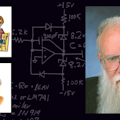Sometimes a lot of power is just right. Sometimes 200 hp in a car is a lot better than 100. Sometimes even 1 hp gets a bicycle up the hill quite fast. Yet a bicycle can cruise along at 6 or 8 mph with less than 0.1 hp. That's part of the elegance of the bicycle, as an extremely efficient mode of transportation.
Yet by using external sources of power, I can go uphill much faster than I can by pedaling my bike. The dollars per mile can drop way down, if I count my time at even $5 an hour.
A 747 at takeoff is generating perhaps 50,000 hp. Yet its controls rely on tiny forces and low-power circuits, in the milliwatt or microwatt levels. Radio signals may be kilowatts when transmitted, but nanowatts when received. We engineers require the ability to comprehend this entire range of power—and to engineer control circuits that are appropriate.
Power is useful when it's in the right place, yet it can be disastrous in the wrong place. So, our task is to keep power in the right place. Sometimes a plain old linear regulator with an efficiency of 30% to 50% is just right. Many other cases definitely call for a switch-mode regulator.
Recently we had a high-power, high-current, high-speed, medium-voltage driver. A potential customer asked us if we could soup it up from 5 V of VS to 8 V to drive a couple hundred milliamperes into a higher-voltage load. Well, we said, it does no harm to try. We applied the juice and monitored the temperature of the calibrated ESD diode, which was at the edge of the die. It went up to 175°C. One of the engineers said, "Well, it's a good thing the temperature is constant, all across the die, because we really don't want it to get hotter than that, for best reliability."
But a couple of us guys were suspicious. I computed that the middle of the die could be 60°C or 70°C hotter than the edge. We got mad and etched away the encapsulation and took an IR photo. The middle of the die was indeed 85°C hotter than the ESD diode. It ran at 260°C, all weekend. On Monday, it was still working fine. Then we had to tear down that experiment to do other tests. But we showed that this part could handle a lot of power, get the heat out, and keep running well.
We wouldn't want to recommend that the part would run this hot, for good reliability. But if we added a decent heatsink, we could keep it cool enough to run reliably. Getting the milliamperes out does make it challenging to get the heat out, but not impossible. (A metal heatsink does a much better job than a paper heatsink.)
BOB'S MAILBOX
Dear Bob: About "Resonance Stuff" (electronic design, Jan. 13, p. 22): That is an interesting tale and one that I have also experienced! My wife inherited this cabin up in western Mass., and it was a very basic structure with a simple bed that had a coil spring frame to support the mattress. The open springs had very high Qs, so any humming or spoken sound while lying on the bed was amplified considerably! I never took the trouble to haul up a mic, preamp, and scope to analyze this, but we used to joke about the springs doing this! I don't quite follow what the picture of the scope trace in your article is displaying, other than that it looks like bursts of some frequencies!
Dale B. Blackwell (via e-mail)
Pease:
As I said, it was a poor simulation. The real amplitude (as soon as I stopped humming) was at a moderately low level, and then the amplitude rose by 3 dB, then fell by 3 dB, and then rose 6 dB, then fell off, after a total delay of a couple of seconds.
Comments invited!
[email protected] —or:
Mail Stop D2597A, National Semiconductor
P.O. Box 58090, Santa Clara, CA 95052-8090
About the Author

Bob Pease
Bob obtained a BSEE from MIT in 1961 and was a staff scientist at National Semiconductor Corp., Santa Clara, CA, for many years. He was a well known and long time contributing editor to Electronic Design.
We also have a number of PDF eBooks by Bob that members can download from the Electronic Design Members Library.